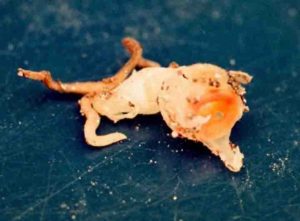
A single non-photosynthetic plant specimen preserved in a Japanese natural history museum has been identified as a new species. However, it is highly possible that this species is already extinct. These findings were published on September 13 in Phytotaxa.
This plant was discovered in Kobe, Japan, in 1992, and preserved with its identity unknown. No new specimens were found in follow-up surveys between 1993 and 1999, and the plant’s original habitat was destroyed by land development in 1999.
A research team led by Project Associate Professor Kenji Suetsugu (Kobe University Graduate School of Science) is carrying out surveys to classify the taxonomy and ecology of non-photosynthetic plants called mycoheterotrophs. These plants do not photosynthesize, instead leading a parasitic existence drawing nutrients from fungi and tree roots. Many species only appear above ground during brief fruiting and flowering periods, making them very hard to find and identify.
As part of the survey, Professor Suetsugu, in collaboration with Dr. Nobuhira Kurosaki (Visiting Professor at the University of Hyogo) and independent botanists Mr. Osamu Nakanishi and Mr. Tomiki Kobayashi, re-examined a plant specimen preserved in the Museum of Nature and Human Activities, Hyogo. The specimen in this study was originally found in 1992 in the Nishi district of Kobe by the above-mentioned Mr. Nakanishi and Mr. Kobayashi, accompanied by Mr. Takashi Saburomaru.
When first discovered, the plant was identified as belonging to the family Burmanniaceae because of its non-photosynthesizing properties and the unusual shape of its flowers. It seemed to be closely related to the Oxygyne hyodoi species discovered in Japan’s Aichi prefecture, but it was not clear whether the specimen was O. hyodoi itself or something else. This time, after close scrutiny of the plant’s morphological characteristics, the team showed that it was not a member of Oxygene but Thismia, mainly due to the position and shape of the anthers. After dissecting the flower and closely studying the shape of the petals and stamen, they realized that it had characteristics not found in any other species of Thismia identified so far. The team named it Thismia kobensis after its place of discovery, and presented it as a new species.
Thismia kobensis was discovered in 1992 as a single specimen, with no further samples of the same species found. In 2010 it was reported as extinct by Hyogo prefecture. “Because it has now been recognized as a new species, we are hopeful that living specimens of T. kobensis can be discovered in other places.” says Professor Suetsugu.
Mycoheterotrophic plants are parasites — in order to survive they need a stable ecosystem with abundant resources, and they are very sensitive to environmental changes. Therefore, a large number of mycoheterotrophs are now in danger of extinction, and this study strongly suggests that some mycoheterotrophic species may be dying out before they are recognized.
Many plant specimens are preserved in museums. Even if the original collector is unable to identify the specimen, samples stored by public organizations can be identified by future generations. This discovery of a new species, based on a specimen of a plant that is presumably extinct, highlights the importance of collecting specimens in order to fully understand the biodiversity of our environment.
Reference:
Kenji Suetsugu, Osamu Nakanishi, Tomiki Kobayashi, Nobuhira Kurosaki. Thismia kobensis (Burmanniaceae), a new and presumably extinct species from Hyogo Prefecture, Japan. Phytotaxa, 2018 DOI: 10.11646/phytotaxa.369.2.6
Note: The above post is reprinted from materials provided by Kobe University.










